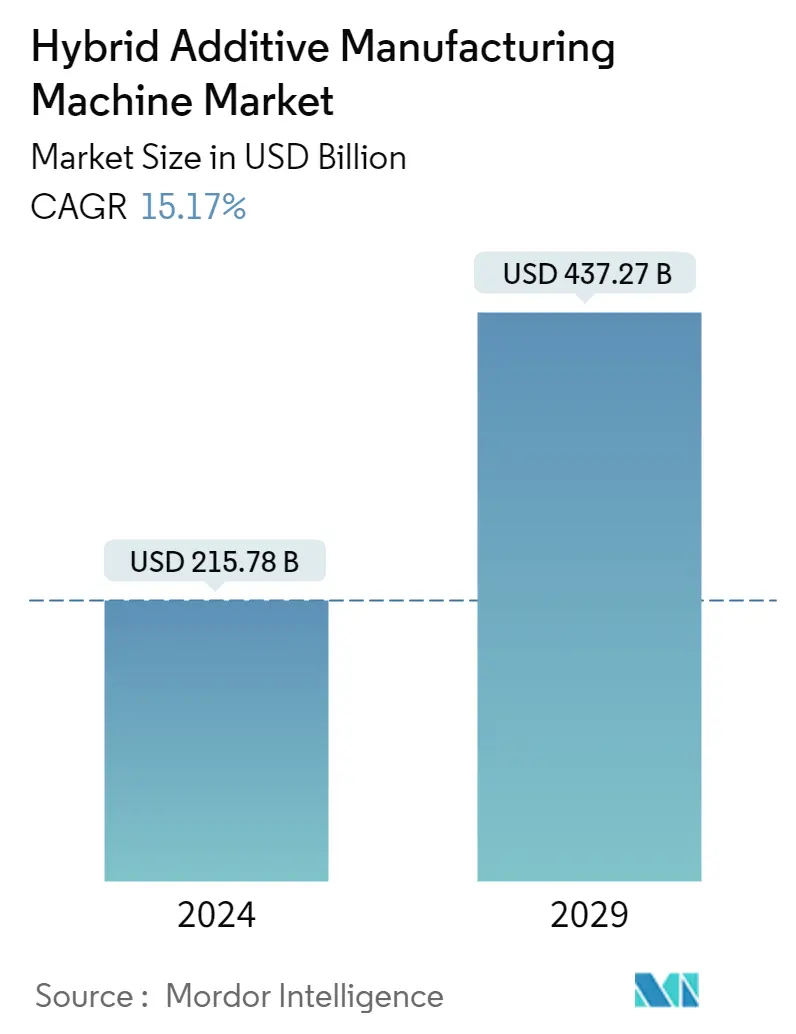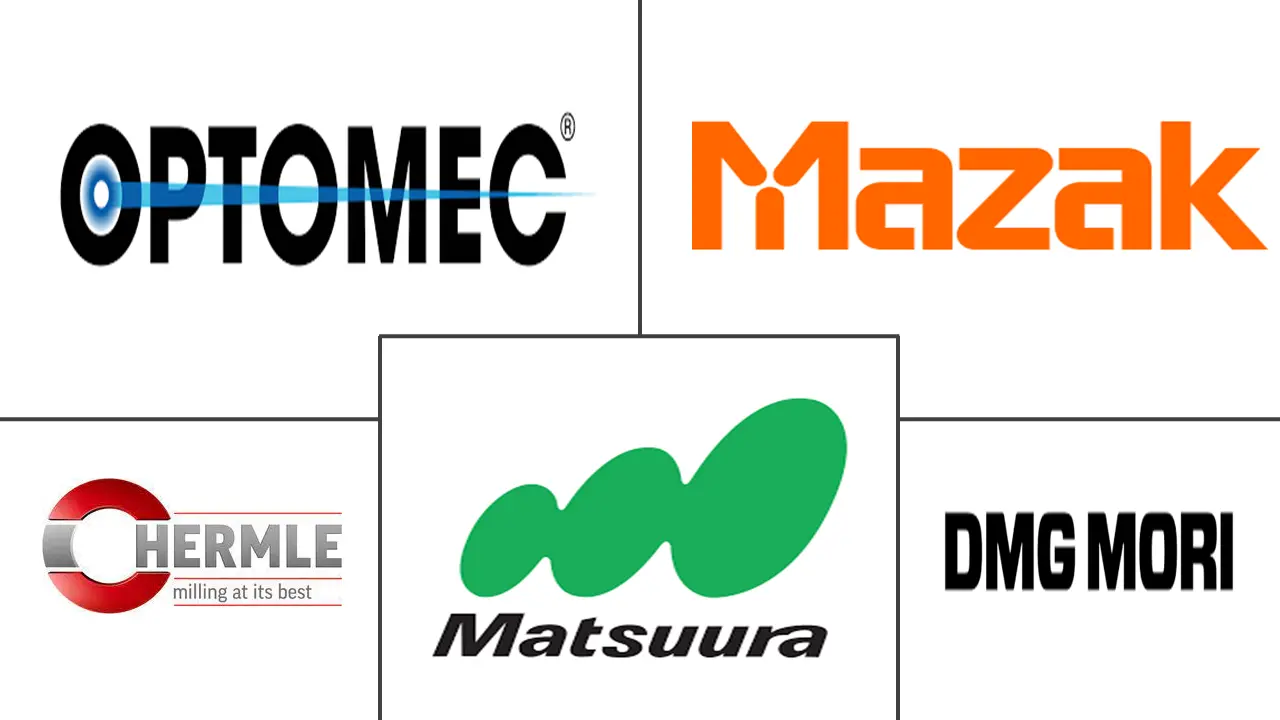Market Size of Hybrid Additive Manufacturing Machine Industry

| Study Period | 2020 - 2029 |
| Market Size (2024) | USD 215.78 Billion |
| Market Size (2029) | USD 437.27 Billion |
| CAGR (2024 - 2029) | 15.17 % |
| Fastest Growing Market | Europe |
| Largest Market | North America |
| Market Concentration | Medium |
Major Players
*Disclaimer: Major Players sorted in no particular order |
Hybrid Additive Manufacturing Machine Market Analysis
The Hybrid Additive Manufacturing Machine Market size is estimated at USD 215.78 billion in 2024, and is expected to reach USD 437.27 billion by 2029, growing at a CAGR of 15.17% during the forecast period (2024-2029).
The market is driven by the increasing demand from the aerospace, defense, and automotive industries.
Hybrid manufacturing is the process of putting both subtractive and additive processes into a single machine. The market is mostly driven by the fact that both processes can be done on one machine. This is especially true in the aerospace, defense, and automotive industries. It makes manufacturing effortless with the capability to switch between two processes instantly. Although the technology is relatively new, much like 3D printing, the potential benefits of hybrid additive manufacturing have made the adopters of the technology very optimistic about the technology’s prospects. The COVID-19 epidemic halted the production of several items in the hybrid additive manufacturing machine sector, mostly because of the extended lockdown in important international markets. This severely slowed the market growth for hybrid additive manufacturing equipment during the past several months. COVID-19 impacted equipment and machinery sales in the first quarter of 2020, and market growth suffered throughout the year.
Hybrid manufacturing also makes parts as they are needed, so there is no need to keep expensive and space-consuming stock. With hybrid additive manufacturing, manufacturers can produce custom materials and rapid prototypes and provide an opportunity for new products and better efficiency. Recently, in January 2023, the US Navy installed a Phillips additive hybrid metal 3D printing solution on USS Bataan. Also, using this equipment in different industries helps to reduce the bad effects on the environment. The hybrid production processes release fewer chemical and hazardous pollutants and account for a major reduction in the carbon footprint.
Also, hybrid additive manufacturing makes up for some of the flaws of the additive manufacturing system by using multi-axis systems that let the parts being made move in any direction. Also, 95% waste reduction, better efficiency, capabilities for process development and material characterization, and material and material cost savings, etc., are some of the major benefits that are further augmenting the adoption of hybrid additive manufacturing machines across sectors. However, high initial investments and installation costs associated with these machines are hindering market growth. Further, SMEs and manufacturing companies with low investment capabilities are unable to deploy the machinery due to the high initial investment costs.
Additionally, the machines require skilled and well-trained labor to operate them. To maintain equipment performance and eliminate system breakage issues, companies need to incur huge costs to provide professional training sessions for workers. Nikon Corporation (Nikon) has disclosed a recent investment in Hybrid Manufacturing Technologies Global, Inc. An integration technique that enables users to integrate additive tools onto any platform was successfully developed by Hybrid Manufacturing Technologies Global, Inc. (HMT), an award-winning industry leader in additive manufacturing (AM). By combining several complementary technologies in a single setup, this ground-breaking solution enables users to fully use the production process.
Hybrid Additive Manufacturing Machine Industry Segmentation
Additive manufacturing, also known as 3D printing, is an automated process used to create rapid prototypes and functional end-use parts. It takes virtual designs from Computer-Aided Design (CAD) software and transforms them into thin, virtual, horizontal layer-wise cross-sections until the model is complete. Hybrid additive manufacturing is a combination of additive and subtractive processes. This integration helps run different processes simultaneously on the same machine. Machines that have both additive and subtractive tools, such as CNC tools, integrated are considered within the scope. A complete background analysis of the hybrid additive manufacturing machine market, including the assessment of the economy and contribution of sectors in the economy, a market overview, market size estimation for key segments, emerging trends in the market segments, market dynamics, and geographical trends, and COVID-19 impact, is covered in the report.
The hybrid additive manufacturing machine market is segmented by end-user industry (aerospace and defense, energy and power, electronics, medical, automotive, and other end-user industries) and geography (North America, Europe, Asia-Pacific, and the rest of the World).
The report offers market size and forecasts for the hybrid additive manufacturing machine industry in value (USD) for all the above segments.
| By End-user Industry | |
| Aerospace & Defense | |
| Energy & Power | |
| Electronics | |
| Medical | |
| Automotive | |
| Other End-user Industries |
| Geography | |
| North America | |
| Europe | |
| Asia-Pacific | |
| Rest of the World |
Hybrid Additive Manufacturing Machine Market Size Summary
The hybrid additive manufacturing machine market is poised for significant growth, driven by increasing demand from sectors such as aerospace, defense, and automotive. This technology integrates both subtractive and additive processes within a single machine, offering seamless transitions between the two methods. The ability to produce parts on-demand reduces the need for extensive inventory, leading to cost savings and efficiency improvements. Despite its relatively nascent stage, the technology's potential benefits have garnered optimism among adopters. However, the market faced challenges during the COVID-19 pandemic, which disrupted production and slowed growth. High initial investment costs and the need for skilled labor remain barriers to wider adoption, particularly for small and medium enterprises.
In the medical sector, hybrid additive manufacturing is gaining traction due to its ability to customize parts and improve surgical outcomes. The technology's advantages, such as reduced product development times and lower manufacturing costs, are driving its adoption in producing surgical equipment, prosthetics, and implants. North America is expected to dominate the market, supported by a strong presence of major players and high consumption across various industries. The region's early adoption of advanced medical technologies and increasing healthcare expenditure further bolster market growth. The competitive landscape is moderately concentrated, with major vendors focusing on innovation and strategic partnerships to enhance their offerings and expand their market reach.
Hybrid Additive Manufacturing Machine Market Size - Table of Contents
-
1. MARKET DYNAMICS
-
1.1 Market Overview
-
1.2 Introduction to Market Drivers and Restraints
-
1.3 Market Drivers
-
1.3.1 Industry 4.0 Integration
-
1.3.2 In industries like healthcare and automotive, there is a growing demand for customized and patient-specific parts.
-
-
1.4 Market Restraints
-
1.4.1 Hybrid additive manufacturing machines are often expensive to acquire and install, which can deter smaller manufacturers and businesses from adopting this technology.
-
1.4.2 Ensuring consistent quality and precision in hybrid manufacturing processes can be challenging, as it requires tight integration between additive and subtractive stages, precise calibration, and maintenance
-
-
1.5 Market Opportunities
-
1.5.1 Increased Adoption in Aerospace and Defense
-
1.5.2 The energy sector, including oil and gas, can benefit from hybrid AM machines for producing complex components and parts with improved corrosion resistance and structural integrity
-
-
1.6 Industry Value Chain Analysis
-
1.7 Industry Attractiveness - Porter's Five Forces Analysis
-
1.7.1 Bargaining Power of Suppliers
-
1.7.2 Bargaining Power of Buyers/Consumers
-
1.7.3 Threat of New Entrants
-
1.7.4 Threat of Substitute Products
-
1.7.5 Intensity of Competitive Rivalry
-
-
1.8 Technology Snapshot
-
-
2. MARKET SEGMENTATION
-
2.1 By End-user Industry
-
2.1.1 Aerospace & Defense
-
2.1.2 Energy & Power
-
2.1.3 Electronics
-
2.1.4 Medical
-
2.1.5 Automotive
-
2.1.6 Other End-user Industries
-
-
2.2 Geography
-
2.2.1 North America
-
2.2.2 Europe
-
2.2.3 Asia-Pacific
-
2.2.4 Rest of the World
-
-
Hybrid Additive Manufacturing Machine Market Size FAQs
How big is the Hybrid Additive Manufacturing Machine Market?
The Hybrid Additive Manufacturing Machine Market size is expected to reach USD 215.78 billion in 2024 and grow at a CAGR of 15.17% to reach USD 437.27 billion by 2029.
What is the current Hybrid Additive Manufacturing Machine Market size?
In 2024, the Hybrid Additive Manufacturing Machine Market size is expected to reach USD 215.78 billion.

